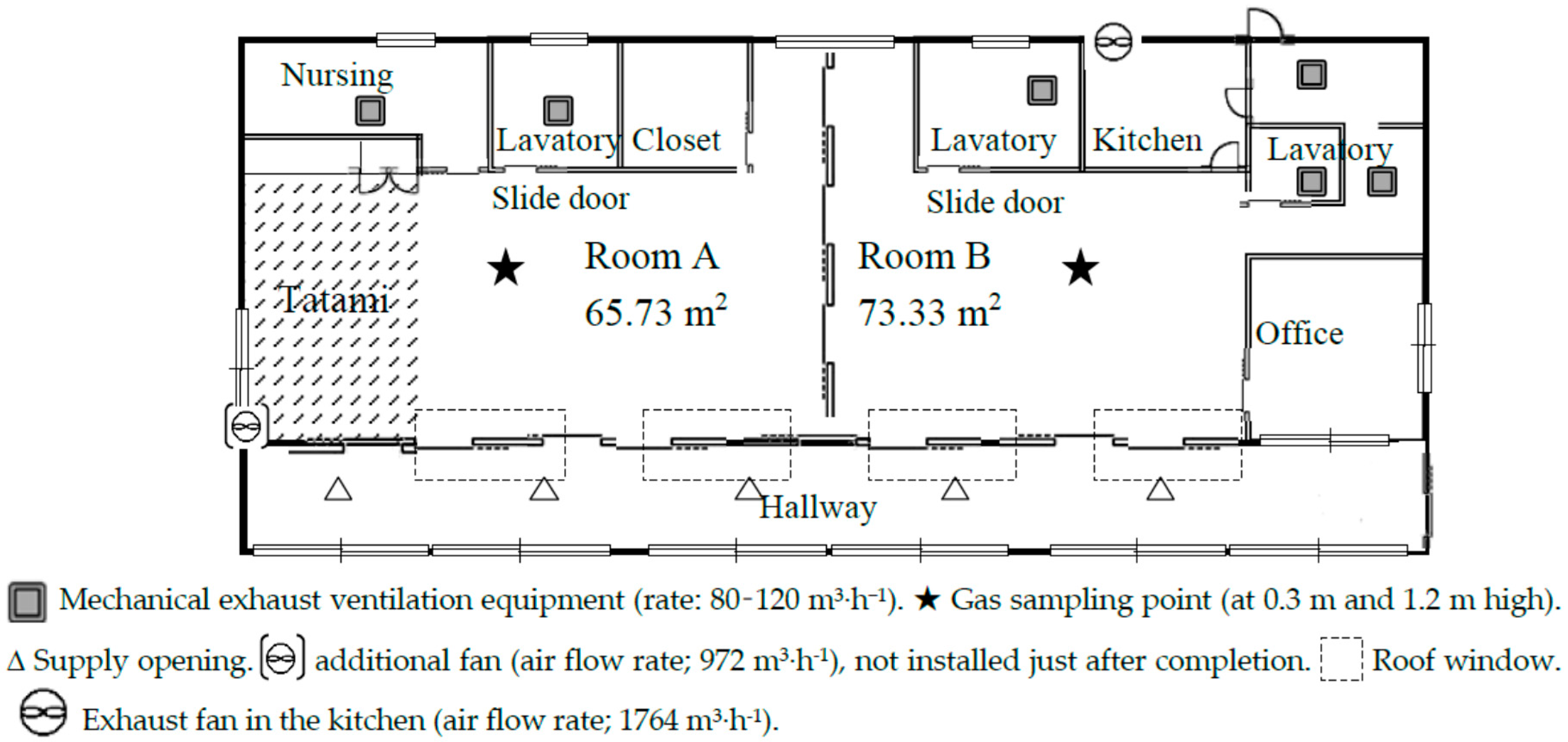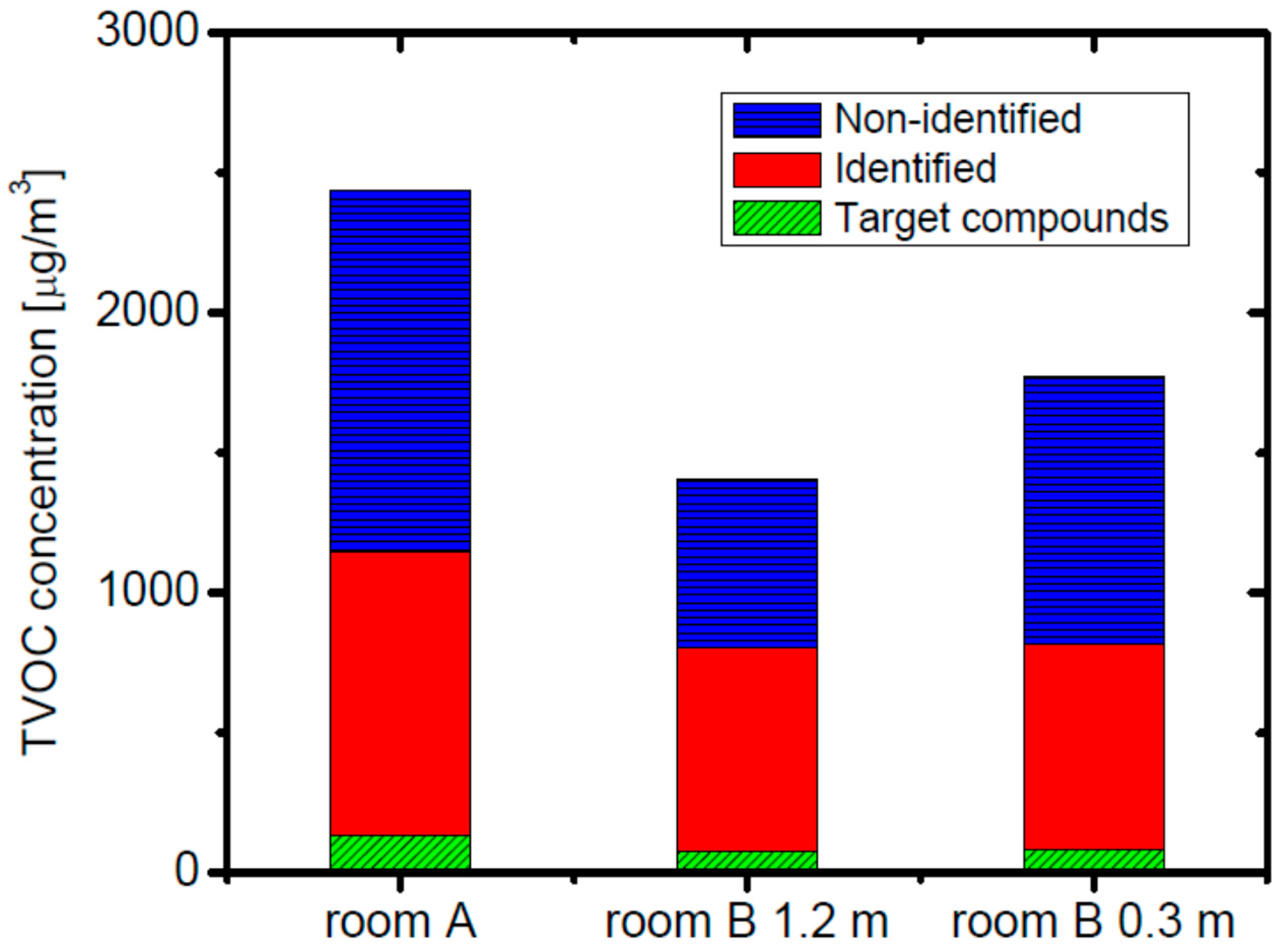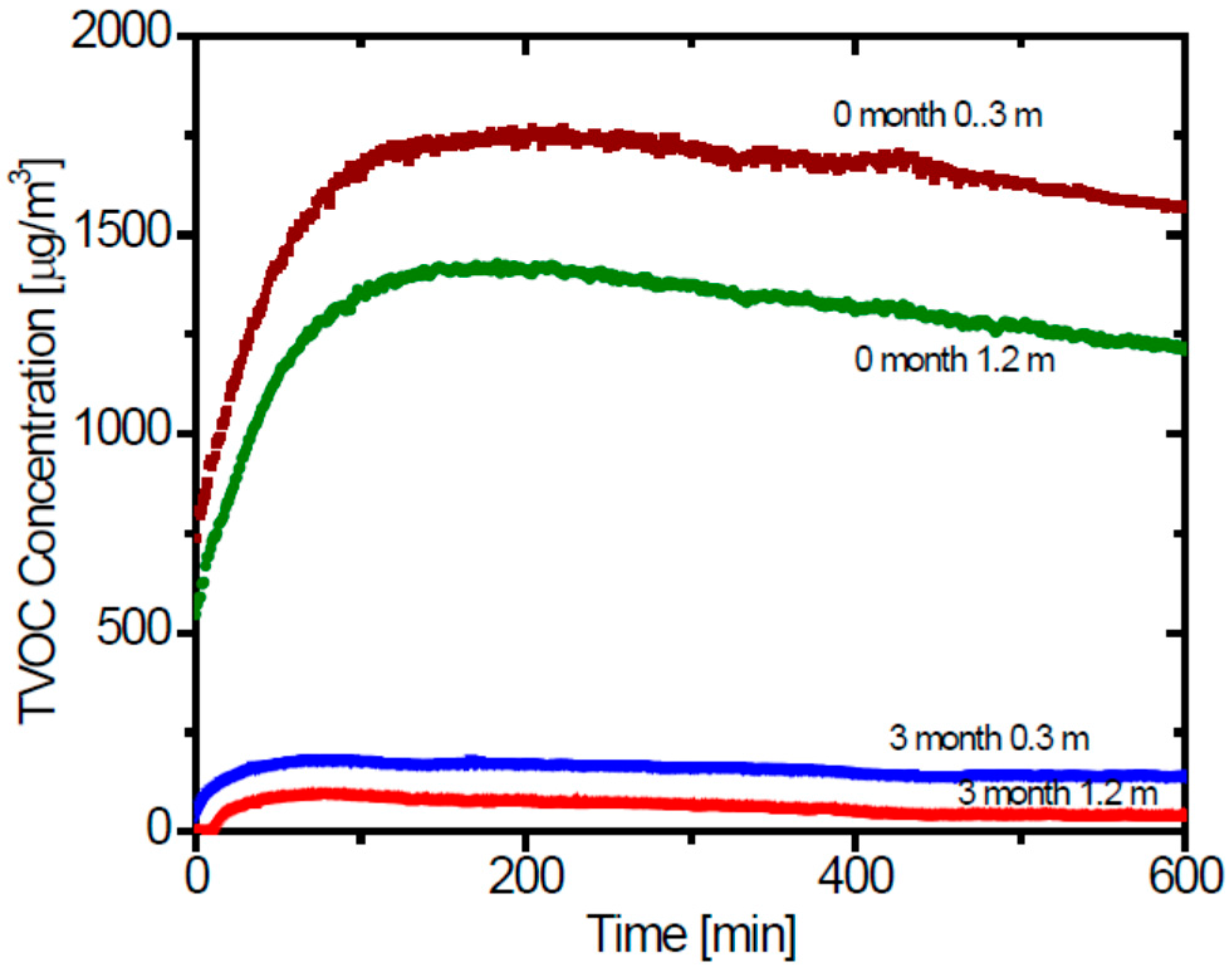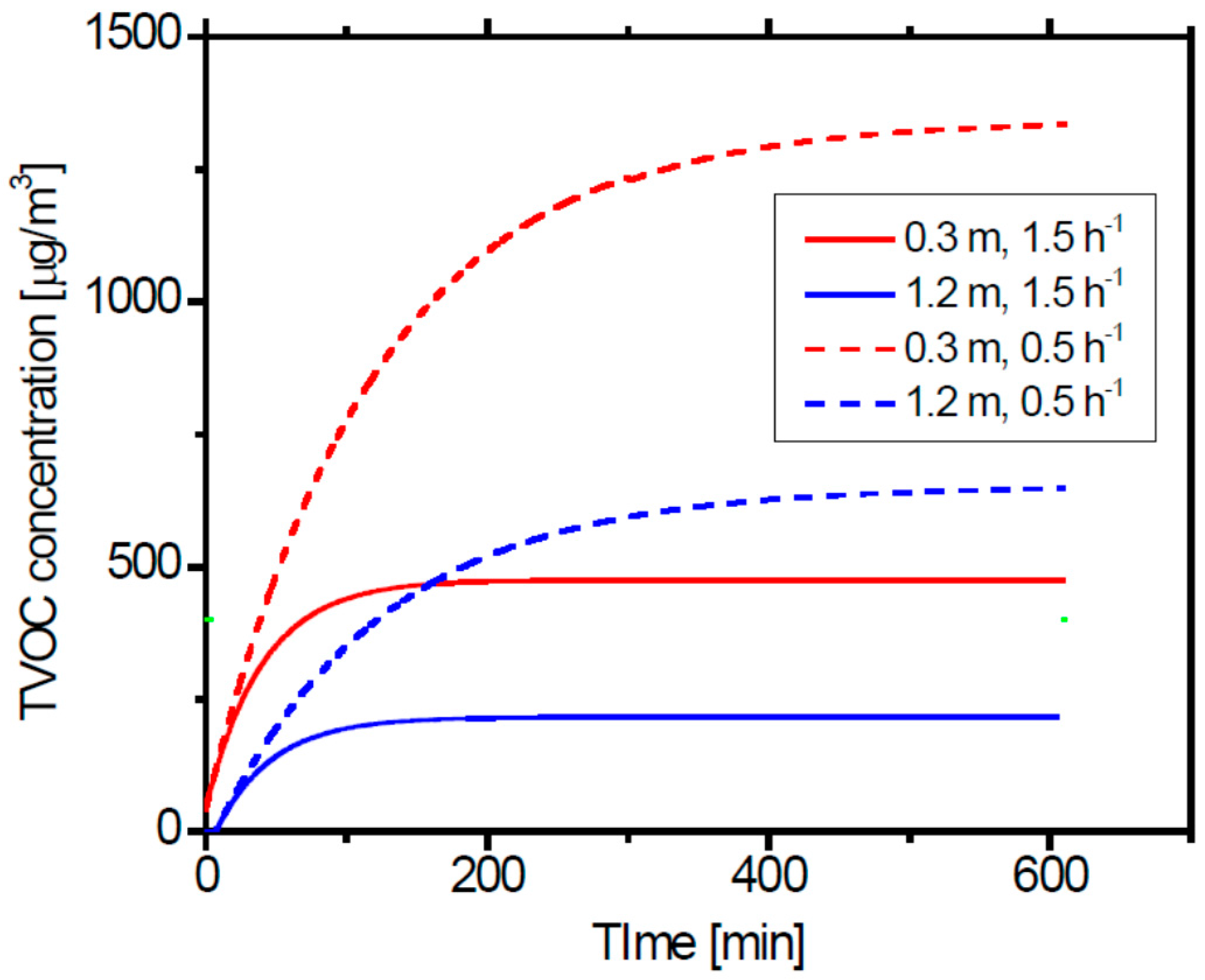Measurements of Volatile Organic Compounds in a Newly Built Daycare Center
Abstract
:1. Introduction
2. Experimental Section
2.1. Field Surveys
2.2. VOC and Carbonyl Compound Measurements
3. Results and Discussion
3.1. TVOC Concentration and VOCs Concentrations
3.2. Estimation of the Air Exchange Rate
4. Conclusions
Acknowledgments
Author Contributions
Conflicts of Interest
References
- Abbritti, G.; Muzi, G. Indoor air quality and health in offices and other non-industrial working environments. Med. Lav. 2006, 97, 410–417. [Google Scholar] [PubMed]
- Jones, A.P. Indoor air quality and health. Atmos. Environ. 1999, 33, 4535–4564. [Google Scholar] [CrossRef]
- Kostiainen, R. Volatile organic-compounds in the indoor air of normal and sick houses. Atmos. Environ. 1995, 29, 693–702. [Google Scholar] [CrossRef]
- Norback, D.; Michel, I.; Widstroem, J. Indoor air quality and personal factors related to the sick building syndrome. Scand. J. Work Environ. Health 1990, 16, 121–128. [Google Scholar] [CrossRef]
- Sarigiannis, D.A.; Karakitsios, S.P.; Gotti, A.; Liakos, I.L.; Katsoyiannis, A. Exposure to major volatile organic compounds and carbonyls in European indoor environments and associated health risk. Environ. Int. 2011, 37, 743–765. [Google Scholar] [CrossRef] [PubMed]
- Zabiegala, B. Organic compounds in indoor environments. Polish J. Environ. Stud. 2006, 15, 383–393. [Google Scholar]
- Zhang, J.; Smith, K.R. Indoor air pollution: A global health concern. Br. Med. Bull. 2003, 68, 209–225. [Google Scholar] [CrossRef] [PubMed]
- Japanese Ministry of Health, Labor and Welfare. Committee on Sick House Syndrome: Indoor Air Pollution, Progress Report No. 4; Summary of Discussions from the 8th to 9th Meetings. Available online: http://www.nihs.go.jp/mhlw/chemical/situnai/kentoukai/rep-eng4.pdf (accessed on 17 February 2016).
- Center for Housing Renovation and Dispute Settlement Support. Summarized Report of Field Survey on Actual IAQ in Japan in 2004; Center for Housing Renovation and Dispute Settlement Support: Tokyo, Japan, 2005. (In Japanese) [Google Scholar]
- Nakazawa, H.; Ikeda, H.; Yamashita, T.; Hara, I.; Kumai, Y.; Endo, G.; Endo, Y. A case of sick building syndrome in a Japanese office worker. Ind. Health 2005, 43, 341–345. [Google Scholar] [CrossRef] [PubMed]
- Takeda, M.; Saijo, Y.; Yuasa, M.; Kanazawa, A.; Araki, A.; Kishi, R. Relationship between sick building syndrome and indoor environmental factors in newly built Japanese buildings. Int. Arch. Occup. Environ. Health 2009, 82, 583–593. [Google Scholar] [CrossRef] [PubMed]
- Takigawa, T.; Wang, B.L.; Saijo, Y.; Morimoto, K.; Nakayama, K.; Tanaka, M.; Shibata, E.; Yoshimura, T.; Chikara, H.; Ogino, K.; et al. Relationship between indoor chemical concentrations and subjective symptoms associated with sick building syndrome in newly built Japanese buildings. Int. Arch. Occup. Environ. Health 2010, 83, 225–235. [Google Scholar] [CrossRef] [PubMed]
- Andersson, K.; Bakke, J.V.; Bjørseth, O.; Bornehag, C.G.; Clausen, G.; Hongslo, J.K.; Kjellman, M.; Kjærgaard, S.; Levy, F.; Mølhave, L.; et al. TVOC and Health in Non-industrial Indoor Environments: Report from a Nordic Scientific Consensus Meeting at Långholmen in Stockholm. Indoor Air 1997, 7, 78–91. [Google Scholar] [CrossRef]
- ECA-IAQ, European Collaborative Action. “Indoor Air Quality and Its Impact on Man” Total Volatile, Organic Compounds (TVOC) in Indoor Air Quality Investigations; Report No 19. EUR 17675 EN; Office for Official Publications of the European Community: Brussels, Luxembourg, 1997. [Google Scholar]
- Jokl, M.V. Evaluation of indoor air quality using the decibel concept based on carbon dioxide and TVOC. Build. Environ. 2000, 35, 677–397. [Google Scholar] [CrossRef]
- Mølhave, L.; Clausen, G.; Berglund, B.; Ceaurriz, J.D.; Kettrup, A.; Lindvall, T.; Maroni, M.; Pickering, A.C.; Risse, U.; Rothweiler, H.; et al. Total volatile organic compounds (TVOC) in indoor quality investigations. Indoor Air 1997, 7, 225–240. [Google Scholar] [CrossRef]
- Todaka, E.; Nakaoka, H.; Hanazato, M.; Seto, H.; Mori, C. Sick building syndrome and total volatile organic compounds. Toxicol. Lett. 2012, 211, S94. [Google Scholar] [CrossRef]
- Brown, S.K. Volatile organic pollutants in new and established buildings in Melbourne, Australia. Indoor Air 2002, 12, 55–63. [Google Scholar] [CrossRef] [PubMed]
- Guo, P.; Yokoyama, K.; Piao, F.; Sakai, K.; Khalequzzaman, M.; Kamijima, M.; Nakajima, T.; Kitamura, F. Sick building syndrome by indoor air pollution in Dalian, China. Int. J. Environ. Res. Public Health 2013, 10, 1489–1504. [Google Scholar] [CrossRef] [PubMed]
- Hodgson, A.T.; Rudd, A.F.; Beal, D.; Chandra, S. Volatile organic compound concentrations and emission rates in new manufactured and site-built houses. Indoor Air 2000, 10, 178–192. [Google Scholar] [CrossRef] [PubMed]
- Hori, M. Total volatile organic compound (TVOC) as an indicator of indoor air quality. Indoor Environ. 2010, 13, 9–19. [Google Scholar] [CrossRef]
- Hori, H.; Ishimatsu, S.; Fueta, Y.; Ishidao, T. Evaluation of a real-time method for monitoring volatile organic compounds in indoor air in a Japanese university. Environ. Health Prev. Med. 2013, 18, 285–292. [Google Scholar] [CrossRef] [PubMed]
- Järnström, J.; Saarela, K.; Kalliokoski, P.; Pasanen, A.-L. Reference values for indoor air pollutant concentrations in new residential buildings in Finland. Atmos. Environ. 2006, 40, 7178–7191. [Google Scholar] [CrossRef]
- Khaleghi, A.; Bartlett, K.; Hadgson, M. Relationship between ventilation, air quality and acoustics in “Green” and “Brown” buildings. Can. Acoust. 2008, 36, 76–77. [Google Scholar] [CrossRef]
- Liu, J.; Bai, G.; Chen, J.; Zhu, L.; Guo, W.; Shen, X. Total volatile organic compound concentration and its influencing factors in urban indoor air after decoration. Chin. Sci. Bull. 2011, 56, 2683–2689. [Google Scholar] [CrossRef]
- Raw, G.J.; Coward, S.K.D.; Brown, V.M.; Crump, D.R. Exposure to air pollutants in English homes. J. Expo. Anal. Environ. Epidemiol. 2004, 14, S85–S94. [Google Scholar] [CrossRef] [PubMed]
- Sakaguchi, J.; Akabayashi, S. Field survey of indoor air quality in detached houses in Niigata Prefecture. Indoor Air 2003, 13 (Suppl. 6), 42–49. [Google Scholar] [CrossRef] [PubMed]
- Yamaguchi, T.; Nakajima, D.; Ezoe, Y.; Fujimaki, H.; Shimada, Y.; Kozawa, K.; Arashidani, K.; Goto, S. Measurement of volatile organic compounds (VOCs) in new residential buildings and VOCs behavior over time. J. Univ. Occup. Environ. Health 2006, 28, 13–27. [Google Scholar]
- Building Center of Japan. Introduction to Building Standard Law; SLIntroduction201307_e.pdf; Building Center of Japan: Tokyo, Japan, 2013. [Google Scholar]
- Sundell, J.; Levin, H.; Nazaroff, W.W.; Cain, W.S.; Fisk, W.J.; Grimsrud, D.T.; Gyntelberg, F.; Li, Y.; Persily, A.K.; Pickering, A.C.; et al. Ventilation rates and health: Multidisciplinary review of the scientific literature. Indoor Air 2011, 21, 191–204. [Google Scholar] [CrossRef] [PubMed]
- Yamamoto, N.; Shendell, D.G.; Winer, A.M.; Zhang, J. Residential air exchange rates in three major US metropolitan areas: Results from the Relationship among Indoor, Outdoor, and Personal Air Study 1999–2001. Indoor Air 2010, 20, 85–90. [Google Scholar] [CrossRef] [PubMed]
- Ferro, A.R.; Klepeis, N.E.; Ott, W.R.; Nazaroff, W.W.; Hildemann, L.M.; Switzer, P. Effect of Interior door position on room-to-room differences in residential pollutant concentrations after short-term releases. Atmos. Environ. 2009, 43, 706–714. [Google Scholar] [CrossRef]
- Fisk, W.J.; Mirer, A.G.; Mendell, M.J. Quantitative relationship of sick building syndrome symptoms with ventilation rates. Indoor Air 2009, 19, 159–165. [Google Scholar] [CrossRef] [PubMed]
- Guo, Z.; Sparks, L.E.; Tichenor, B.A.; Chang, J.C.S. Predicting the emissions of individual VOCs from petroleum-based indoor coatings. Atmos. Environ. 1998, 32, 231–237. [Google Scholar] [CrossRef]
- Järnström, J.; Saarela, K.; Kalliokoski, P.; Pasanen, A.-L. Reference values for structure emissions measured on site in new residential buildings in Finland. Atmos. Environ. 2007, 41, 2290–2302. [Google Scholar] [CrossRef]
- Knöppel, H.; Schauenburg, H. Screening of household products for the emission of volatile organic compounds. Environ. Int. 1989, 15, 413–418. [Google Scholar] [CrossRef]
- Wolkoff, P. Volatile organic compounds—Sources, measurements, emissions, and the impact on indoor air quality. Indoor Air 1995, 5 (Suppl. 3), 1–73. [Google Scholar] [CrossRef]
- Coy, J.D.; Bigelow, P.L.; Buchan, R.M.; Tessari, J.D.; Parnell, J.O. Field evaluation of a portable photoionization detector for assessing exposure to solvent mixtures. Am. Ind. Hyg. Assoc. J. 2000, 61, 268–274. [Google Scholar]
- Mizukoshi, A.; Kumagai, K.; Yamamoto, N.; Noguchi, M.; Yoshiuchi, K.; Kumano, H.; Yanagisawa, Y. A novel methodology to evaluate health impacts caused by VOC exposures using real-time VOC and Holter monitors. Int. J. Environ. Res. Public Health 2010, 7, 4127–4138. [Google Scholar] [CrossRef] [PubMed]
- Peng, F.M.; Xie, P.H.; Shi, Y.G.; Wang, J.D.; Liu, W.Q.; Liu, H.Y. Photoionization detector for portable rapid GC. Chromatographia 2007, 65, 331–336. [Google Scholar] [CrossRef]
- RAE systems. Application & Technical Notes, 3rd ed.; RAE Systems: San Jose, CA, USA, 2005. [Google Scholar]
- Adgate, J.L.; Church, T.R.; Ryan, A.D.; Ramachandran, G.; Fredrickson, A.L.; Stock, T.H.; Moranid, M.T.; Sexton, K. Outdoor, indoor, and personal exposure to VOCs in children. Environ. Health Perspect. 2004, 112, 1386–1392. [Google Scholar] [CrossRef] [PubMed]
- Adgate, J.L.; Eberly, L.E.; Stroebel, C.; Pellizzari, E.D.; Sexton, K. Personal, indoor, and outdoor VOC exposures in a probability sample of children. J. Expo. Anal. Environ. Epidemiol. 2004, 14, S4–S13. [Google Scholar] [CrossRef] [PubMed]
- Mendell, M.J. Indoor residential chemical emissions as risk factors for respiratory and allergic effects in children: A review. Indoor Air 2007, 17, 259–277. [Google Scholar] [CrossRef] [PubMed]
- Le Cann, P.; Bonvallot, N.; Glorennec, P.; Deguen, S.; Goeury, C.; Le Bot, B. Indoor environment and children’s health: Recent developments in chemical, biological, physical and social aspects. Int. J. Hyg. Environ. Health 2011, 215, 1–18. [Google Scholar] [CrossRef] [PubMed]
- Daisey, J.M.; Angell, W.J.; Apte, M.G. Indoor air quality, ventilation and health symptoms in schools: An analysis of existing information. Indoor Air 2003, 13, 53–64. [Google Scholar] [CrossRef] [PubMed]
- Smedje, G.; Norbäck, D. Irritants and allergens at school in relation to furnishings and cleaning. Indoor Air 2011, 11, 127–133. [Google Scholar] [CrossRef]
- Japan Industrial Standard. Measurement Method for Indoor Ventilation (Carbon Dioxide Method) (JIS Standard A1406–1974); Japan Industrial Standard: Tokyo, Japan, 1974. [Google Scholar]






| Compound | Guideline Concentration (μg·m−3) |
|---|---|
| Acetaldehyde | 48 |
| p-Dichlorobenzene | 240 |
| Ethyl benzene | 3800 |
| Formaldehyde | 100 |
| Styrene | 220 |
| Tetradecane | 330 |
| Toluene | 260 |
| Xylenes | 870 |
| ATD-GC/MS | ||
|---|---|---|
| ATD | ATD 650 Turbo matrix (Perkin Elmer, Waltham, MA, USA) | |
| Primary desorption | 300 °C (10 min) | |
| Secondary desorption | 5 °C → 40 °C·min−1 → 300 °C (10 min) | |
| GC/MS | HP6890/HP5973N (Agilent, Santa Clara, CA, USA) | |
| Column | HP-1 MS: 60.0 m length, 250-μm inner diameter, 1.00 μm film (Agilent, Santa Clara, CA, USA) | |
| Carrier gas | He, flow rate: 1 mL·min−1 | |
| Column temperature | 40 °C (4 min) → 7 °C·min−1 → 280 °C (10 min) | |
| Analytical mode | SCAN | |
| Mass range | m/z 33–550 | |
| HPLC | Instrument | HP1100 (Agilent) |
| Column | Ascentis RP-Amide (250 mm length, 4.6 mm inner diameter, 5 μm particles (Sigma-Aldrich, St Louis, MO, USA) | |
| Mobile phase | H2O:CH3CN = 35:65 | |
| Flow rate | 1.0 mL·min−1 | |
| Injection volume | 20 μL | |
| Column temperature | 35 °C | |
| Detector | Diode array detector 360 nm | |
| Concentration (μg·m−3) | ||||
|---|---|---|---|---|
| Compound | Room A, 1.2 m | Room B, 1.2 m | Room B, 0.3 m | Guideline Value |
| Formaldehyde * | 9.5 | 7.4 | 7.0 | 100 |
| Acetaldehyde * | 33.0 | 23.0 | 21.1 | 48 |
| Acetone | 11.8 | 10.3 | 9.2 | - |
| Propionaldehyde | 8.8 | 5.9 | 6.0 | - |
| Crotonaldehyde | 37.7 | 129.0 | 128.1 | - |
| Benzaldehyde | 10.3 | 8.6 | 6.8 | - |
| Isovaleraldehyde | 22.3 | 13.3 | 11.4 | - |
| m, p-Tolualdehyde | 91.4 | 49.3 | 51.5 | - |
| Hexaldehyde | 104.8 | 63.5 | 57.0 | - |
| 2-Propanol | 7.9 | 6.5 | 7.1 | - |
| 2-Butanone | 161.6 | 155.4 | 159.0 | - |
| Ethyl acetate | 139.6 | 117.0 | 69.5 | - |
| Benzene | 10.3 | 8.2 | 6.2 | - |
| Toluene * | 16.9 | 11.2 | 10.7 | 260 |
| n-Butyl acetate | 12.2 | 15.6 | 23.2 | - |
| Ethylbenzene * | 6.4 | 8.3 | 10.7 | 3800 |
| m, p-Xylene * | 4.4 | 5.4 | 7.7 | 870 |
| Styrene * | 60.0 | 12.2 | 15.9 | 220 |
| o-Xylene * | 4.0 | 4.9 | 6.6 | 870 |
| Nonane | 5.6 | 2.5 | 3.1 | - |
| α-Pinene | 124.3 | 54.5 | 79.8 | - |
| p-Ethyltoluene | 20.9 | 7.9 | 10.7 | - |
| m-Ethyltoluene | 16.1 | 4.6 | 10.1 | - |
| 1,3,5-Trimethylbenzene | 6.4 | 7.5 | 8.9 | - |
| Decane | 54.3 | 16.6 | 25.9 | - |
| d-Limonene | 154.1 | 49.1 | 50.6 | - |
| TVOCs (GC/MS) | 2327 | 1218 | 1589 | 400 |
| TVOCs (PID) | 2600 | 1206 | 1668 | |
| Concentration (μg·m−3) | ||||
|---|---|---|---|---|
| Compound | Room A, 1.2 m | Room B, 1.2 m | Room B, 0.3 m | Guideline Value |
| Formaldehyde | 6.30 | 6.01 | 7.06 | 100 |
| Acetaldehyde | 9.48 | 8.75 | 9.74 | 48 |
| Acetone | 15.8 | 15.2 | 12.1 | - |
| Propionaldehyde | <5.0 | <5.0 | <5.0 | - |
| Crotonaldehyde | <5.0 | <5.0 | <5.0 | - |
| Benzaldehyde | <5.0 | <5.0 | <5.0 | - |
| Isovaleraldehyde | <5.0 | <5.0 | <5.0 | - |
| m, p-Tolualdehyde | <5.0 | <5.0 | <5.0 | - |
| Hexaldehyde | 10.0 | 9.58 | 11.3 | - |
| 2-Propanol | 3.66 | 3.15 | 1.28 | - |
| 2-Butanone | - | - | - | - |
| Ethyl acetate | - | - | - | - |
| Benzene | 1.29 | <0.2 | <0.2 | - |
| Toluene | 9.63 | <0.2 | 7.54 | 260 |
| n-Butyl acetate | 1.18 | <0.2 | <0.2 | - |
| Ethylbenzene | 0.687 | <0.2 | <0.2 | 3800 |
| m, p-Xylene | 1.11 | <0.2 | <0.2 | 870 |
| Styrene | 2.39 | <0.2 | <0.2 | 220 |
| o-Xylene | 0.687 | <0.2 | <0.2 | 870 |
| Nonane | 1.44 | 0.25 | 0.35 | - |
| α-Pinene | 82.4 | 34.1 | 40.1 | - |
| p-Ethyltoluene | 1.12 | <0.2 | 0.22 | - |
| m-Ethyltoluene | 1.09 | 3.87 | 4.56 | - |
| 1,3,5-Trimethylbenzene | 0.934 | 0.311 | 0.470 | - |
| Decane | - | - | - | - |
| d-Limonene | 11.3 | 0.876 | 3.17 | - |
| TVOCs (with GC/MS) | 201 | 48.5 | 82.0 | 400 |
| TVOCs (with PID) | 110 | 170 | 200 | |
| Time of Measurement | Position Measured | Air Change per Hour (ACH), N = F/V (h−1) | Emission Rate, E (mg·h−1) |
|---|---|---|---|
| Just after completion | 0.3 m high | 1.5 | 700 |
| 1.2 m high | 1.5 | 584 | |
| After three months of completion | 0.3 m high | 3.5 | 63 |
| 1.2 m high | 3.5 | 126 |
© 2016 by the authors; licensee MDPI, Basel, Switzerland. This article is an open access article distributed under the terms and conditions of the Creative Commons Attribution (CC-BY) license (http://creativecommons.org/licenses/by/4.0/).
Share and Cite
Noguchi, M.; Mizukoshi, A.; Yanagisawa, Y.; Yamasaki, A. Measurements of Volatile Organic Compounds in a Newly Built Daycare Center. Int. J. Environ. Res. Public Health 2016, 13, 736. https://doi.org/10.3390/ijerph13070736
Noguchi M, Mizukoshi A, Yanagisawa Y, Yamasaki A. Measurements of Volatile Organic Compounds in a Newly Built Daycare Center. International Journal of Environmental Research and Public Health. 2016; 13(7):736. https://doi.org/10.3390/ijerph13070736
Chicago/Turabian StyleNoguchi, Miyuki, Atsushi Mizukoshi, Yukio Yanagisawa, and Akihiro Yamasaki. 2016. "Measurements of Volatile Organic Compounds in a Newly Built Daycare Center" International Journal of Environmental Research and Public Health 13, no. 7: 736. https://doi.org/10.3390/ijerph13070736
APA StyleNoguchi, M., Mizukoshi, A., Yanagisawa, Y., & Yamasaki, A. (2016). Measurements of Volatile Organic Compounds in a Newly Built Daycare Center. International Journal of Environmental Research and Public Health, 13(7), 736. https://doi.org/10.3390/ijerph13070736






